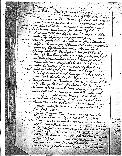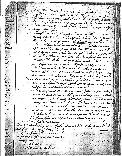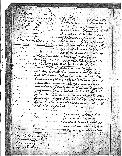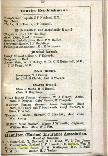See also
- Samuel SALTUS's father: Samuel 1 SALTUS (1643-1722)
- Samuel SALTUS's siblings: Francis 3 SALTUS (c. 1700-aft1722) and Margaret SALTUS (c. 1700-aft1722)
Samuel SALTUS (bef1700-1782)
1. Samuel 2 SALTUS, son of Samuel 1 SALTUS (1643-1722), was born before 1700. He married Esther VINCENT in 1722. He died in 1782. He married Love UNKNOWN.
Love UNKNOWN was born circa 1700. She and Samuel 2 SALTUS had the following children:
| +2 |
Esther VINCENT, daughter of John VINCENT ( -bef1691) and Elizabeth WITTER (bef1675-bef1707), was born circa 1705 in Bermuda. She died on 28 March 1773 in Bermuda. She and Samuel 2 SALTUS had the following children:
| +3 | |
| +4 | |
| +5 | |
| +6 | |
| +7 | |
| +8 |
Second Generation
2. Love SALTUS, child of Samuel 2 SALTUS and Love UNKNOWN, was christened on 15 October 1716 in Pembroke, Bermuda.
3. Esther SALTUS, daughter of Samuel 2 SALTUS and Esther VINCENT, was born on 18 April 1723 in Southampton, Bermuda.
4. Samuel 3 SALTUS, son of Samuel 2 SALTUS and Esther VINCENT, was born on 18 October 1724 in Southampton. He married on 21 April 1750 in Bermuda. He died "1784/1788".
Samuel 3 SALTUS had the following children:
| +9 | |
| +10 | |
| +11 |
5. Vincent SALTUS, son of Samuel 2 SALTUS and Esther VINCENT, was born on 18 November 1725 in Southampton.
6. Whitter SALTUS, son of Samuel 2 SALTUS and Esther VINCENT, was born on 15 December 1726 in Southampton.
7. Norwood SALTUS, son of Samuel 2 SALTUS and Esther VINCENT, was born on 5 November 1727 in Southampton. He married Susanna STILES on 7 May 1750 in Bermuda.
Susanna STILES and Norwood SALTUS had the following children:
| +12 | |
| +13 |
8. Frances SALTUS, daughter of Samuel 2 SALTUS and Esther VINCENT, was born on 13 December 1730 in St Anne's Bay, Southampton, Bermuda. She married John 5 INGHAM in 1767.
John 5 INGHAM, son of John "Carpenter" INGHAM (1680-1769) and Mary UNKNOWN ( - ), was born circa 1740. He died after 1770. He and Frances SALTUS had the following children:
| +14 | |
| +15 | |
| +16 | |
| +17 | |
| +18 |
Third Generation
9. Samuel 3' SALTUS, son of Samuel 3 SALTUS, was born on 12 November 1751 in Southampton, Bermuda. He was christened on 19 November 1751 in Southampton.
10. Whitter SALTUS, son of Samuel 3 SALTUS, was christened on 4 November 1754 in Southampton. He died after 1773.
11. Hinson SALTUS, son of Samuel 3 SALTUS, was born in 1758. He was buried on 16 September 1814 in Pembroke, Bermuda.
12. Esther SALTUS, daughter of Norwood SALTUS and Susanna STILES, was christened on 28 February 1752 in Southampton.
13. Sarah SALTUS, daughter of Norwood SALTUS and Susanna STILES, was christened on 28 September 1753 in Southampton.
14. Captain Joseph INGHAM, son of John 5 INGHAM and Frances SALTUS, was born on 19 September 1764 in Bermuda. He married Sarah STARR on 25 January 1789 in Chatham-Portland, Conn., USA. He died on 19 January 1853 in Western, Oneida County, NY, USA. He was buried in Carmichael Hill. He married Dolly MILLER.
"Captain Joseph".
Sarah STARR, daughter of Captain David STARR (1738-1813) and Ruth MOORE (1742-1786), was born on 21 December 1767 in USA? She died on 17 January 1804 in USA. She was buried in 1 Starr Hill, 2 CarmichaelHill, USA. She and Joseph INGHAM had the following children:
| 19 | Frances Starr INGHAM (1791-c. 1882). Frances was born on 11 June 1791 in Middletown, Conn., USA. She died circa 1882 in Theresa, Jefferson Co., NY, USA. |
| 20 | Joseph Jnr INGHAM (1792-1847). Joseph was born on 21 February 1792 in Middletown. He died on 24 September 1847 in Chicago, Ill., USA. He was buried in Sugar Grove, Kane Co., Ill., USA. |
| 21 | John 8' INGHAM (1794-1878). John was born on 29 May 1794 in Steuben, Oneida Co., NY, USA. He died in 1878. |
| 22 | Samuel Saltus 1' INGHAM (1801-1864). Samuel was born on 24 May 1801 in Steuben. He died on 17 March 1864. |
Dolly MILLER was born on 26 December 1767. She died on 25 February 1861. She was buried in Carmichael Hill, USA.
15. Margaret INGHAM (known as 'Peggy'), daughter of John 5 INGHAM and Frances SALTUS, was born circa 1769. She was buried on 13 January 1859 in Southampton.
16. Samuel Saltus INGHAM MCP, JP, son of John 5 INGHAM and Frances SALTUS, was born in 1769 in Bermuda. He appeared in the census. He was a Member of the Colonial Legislature, Bermuda. He married Mary BUTTERFIELD on 19 December 1802 in Paget, Bermuda. He married Elizabeth James FRITH after 1809. He married Mary Ann Airth NASH on 12 April 1838 in Sandys Parish, Bermuda. He died on 18 April 1849 in at home (Radnor), Southampton, Bermuda. He was buried on 19 April 1849 in family vault, Paget, Bermuda.
Samuel Saltus Ingham, operator of a Bermuda-based shipping company, also became heavily involved in the politics of the island. At his death at the age of eighty, in 1849, in a life which spanned the heyday of Bermuda as a sea-trading nation, through the rigours and starvation of the American War of Independence, to the eventual decline of Bermuda's power,his success is witnessed by the wealth and property which his will lists, and which he distributes amongst his children. On a personal note, in a life of which we have very little in the way of personal details, in his will he also leaves his Horse and Carriage to his wife Mary Ann Airth, in addition to a Basin Stand and various other items presumably of sentimental value! His obituary in the Royal Gazette, Tuesday April 24, 1849, reads :
Died, at his residence, Southampton, on the morning of Wednesday last, in the 80th year of his age, Samuel Saltus Ingham, Esq., much and deservedly regretted by his family and a large circle of relations and friends. Mr Ingham has been for many years a Member of the Colonial Legislature, and has fulfilled his duty to his constituents with much zeal and ability - he was truly an honest man. - His remains were deposited in the family vault in Paget on Thursday. His funeral was most numerously attended.
An insight into Ingham's business can be gleaned from his Shipping Ledger during the years 1802-1811. His firm operated out of Kingston, Jamaica. The journal mentions many well-known Bermudian figures, and also offers a great insight into the dynamics of slavery as it existed in the island. When the Bermudian privateer Regulator was captured by an American ship in 1782, late in the War of Independence, the American captors were amazed to find that Captain George Kidd presided over a crew of five whites and seventy black slaves: at the trial which followed, the Massachusetts justices, with a magnanimous gesture, offered the slaves their liberty: yet every single one of them refused, expressing their wish to return to Bermuda. This incident shows several things: firstly it possibly reflects the poor conditions throughout America which black people experienced; but it also reflects the many advantages that Bermudian slaves had over others in the region. Throughout the eighteenth century, Bermuda had moved towards an almost total maritime-based economy, following on from the demise of the original Somer Island Company (which owned the island from its discovery in 1609 until 1684, when the island reverted to the British crown, and which had exclusively promoted tobacco growing on the island). From 1684 until the War of Independence the shipping trade burgeoned, and the tobacco trade went rapidly into decline. The Bermudan sloop became famous for its speed. Maritime traders throughout the region could not compete with it, as they could not compete economically: Bermudian ships used slave labour, and although slaves lived in very different circumstances than elsewhere - there was much more racial integration and the financial rewards of the business were often shared with the slaves (who were often highly skilled workers) who were mostly treated very well - slavery is still slavery, and Bermudian shippers could operate much more cheaply than their continental competitors. The War of Independence brought terrible hardships for the Bermudians, as the Americans boycotted British trade (which included the British colony Bermuda). The island suffered starvation. Ingham went through this as a young boy, and built his successful business in the aftermath. His career spans this period, which witnessed a spectacular decline in the fortunes of Bermuda as a maritime trading nation, and its success is a tribute to his abilities and toughness.
A glimpse into Ingham's work is gleaned from an entry in the journal of one John Harvey Darrell: "On the 21 July 1814 a convoy set sail for England, which included five or six merchantmen under naval escort, including a small brig belonging to Samuel Saltus Ingham, very deeply laden and carrying several passengers".
Presumably on account of his powerful position as a trader,landowner and person of importance in the island, Ingham became a member of the Legislature (for Southampton), which he retained after he moved to Paget.
Ingham's first wife was Mary Butterfield, whom he married in 1802 and the age of 33. They had two daughters, Mary A and Susan, but Mary (mother) died six and a half years into the marriage. Some time later, Ingham married a woman hlaf his age, Elizabeth Frith, who was from a well-known Bermudian family; the couple had two daughters, Frances and Eliza, before (in 1816) finally producing a son, whom they named Samuel Saltus, after his father. Mrs. Ingham died in 1836, after about 25 years of marriage. A year and a half later, at the age of 68, Ingham married for a third time, to Mary Ann Airth Nash, a girl of about 17 years of age, who was almost certainly the sister of his son-in-law!
In his late sixties, on June 14th 1836, Ingham gave a speech in the House of Assembly, in which he attributes much of the blame for the decline in Bermuda's economy to the Assembly's regulations that all trade had to be undertaken via the capital, Hamilton: the speech, as well as being a plea for a change in this legislation, also gives a detailed picture of contemporary Bermuda. It is interesting to note, however, that slavery had been abolished the previous year (1835) in Bermuda, and it had impacted on Ingham's personal life to the extent that he had owned 16 slaves, and gone through the process of applying for compensation for the loss of these slaves (!), it must further have impacted on his business in that abolition would have greatly increased the costs of trade: nonetheless, Ingham does not mention slaves or slavery once in his speech. The transcript of the speech is reproduced here in full:
About the year 1778 the country was in a state of starvation; there was in consequence a deputation sent from these Islands to New York to Admiral and General Howe to crave relief. Mr. Henry Tucker, the late President and Mr. Nathaniel Jones were deputed; they were politely received and the General observed in reference to their mission that he had experienced much distress himself and could do nothing for Bermuda; but the Admiral told the Deputation that the only thing that could be done for their relief was to order the Ships of War off the Station and as they, the Bermudians, had plenty of fast sailing vessels they would soon be able to find relief, meaning, no doubt, in a trade with America. A short time after this a vessel arrived with a cargo of rice and corn; the owners waited on the Governor and told him that they had a vessel at the west end of the Island with provisions and that if he would allow him to enter without asking any questions they would order her in. The Governor consented on condition that they would give 1/3 of the cargo to St. Georges and to the Troops, which, after fixing the price the owners consented to; the vessel thereupon entered and the cargo was distributed accordingly. About this period Port Royal contributed largely to the relief of the Lower Parishes. That parish was in a high state of cultivation and it is remembered by many now living that the Lower Parishes did receive their daily supplies from Port Royal - part of the production of the land. Port Royal at this time was supposed to be one of the richest Parishes in the Island. It owned a large proportion of the vessels; Ship-building was carried on to a great extent - there were 4 blacksmiths' shops (one of them with 2 forges) in full work. It had a large Militia mustering usually 70-80 men when perhaps 2/3 of the population were at sea. Some time before this the Governor took on himself occasionally to order vessels to St. Georges to enter at the Custom House. The people bore this with tolerable composure till one of the vessels got on shore in coming up and was nearly lost; then it seems the People remonstrated and in 1784 there was an Act passed, authorizing the entry of vessels at the Customs, by producing a certificate from the "Waiter" or "Searcher" - appointed for the West End - of this having visited the vessel. About 1788 there were more vessels it was considered owned in Port Royal and part in Somerset which must have had at least 13 vessels which rendezvoused at the "Horse Shoe"; they had 3 whalers which were very successful; several vessels trading to Hunduras and several European trades; besides traders betweeen this and America and between America and the West Indies. After the French Revoutionary War they had several very heavy privateers that did great execution in taking and destroying the enemy's privateers, protecting the trade of the island and taking many valuable prizes. In 1789 there was an Act passed for the removal of the seat of Government. That Act, I believe, never received the Royal Assent for in a subsequent one of 1792 for the collection of trade, it is spoken of as being then in London, and it seems that the Act of 1798 declared the Act for the Collection of Trade shall commence on Jan. 1st 1799. I think there were then 7 privateers out of the parishes of Port Royal and Somereset as both the Privateers and Whalers were generally manned from them. These Parishes had lost somewhat of their former affluence; but like all other speculations it would no doubt have rallied but for the Act for the collection of Trade. From that period they may trace their downfall; the vessels being obliged to come to Hamilton, the men to get employment must follow and often in the winter months not get more than one days hire out of a week; many after coming down, the weather having proved bad had to go back disappointed, dispirited, discouraged, dissatisfied and some that depended on their labour for support, without a mouthful for themselves or their families; this drove many of the young men from the Island. Others dwindled in poverty. All this they attribute to the depriving them of their rights. Instead of bringing their vessels to their doors when they could go to their work either in their gardens or on board their vessels at sun rise, not losing a day or even an hour and at the same time have the use of their fishing boats, which usually furnished fish for the people they employed, their families and occasionally their neighbours... In stating the above greivances it is to be hoped the Legislature will do something for the relief of the country....They can see no chance of being relieved but by removing the restrictions on the trade of the Island. If those restrictions were removed the number of vessels would increase rapidly; those that have money in America would draw it out, when they know they could take their vessels to their doors, put on their short jackets and go to work at sunrise, in place of now being compelled to dress themselves fully to go to Hamilton; lose half their time going and returning, besides being deprived of the use of the fishing boats.... In 1789 there were 213 vessels registered here; since then the whole of the Western World has been improving except our little Island, which is now reduced to about 40 vessels.
His Will, probated in 1849, confirms the name of his widow and his children. He was first married in 1802 to Mary Butterfield. His Will states that the name of his widow was Mary Ann Airth, daughter of John Nash. There is still some uncertainty here. Captain John Nash is not known to have had a daughter of this name, but his son, also John Nash, did have a daughter named Marianna Airth Nash. This would suggest that Saltus married the rather young sister of his son-in-law, Robert Bassett Nash.
He also had a second wife, Elizabeth. Records are very sketchy for Saltus (senior), and no baptism information for his children has been found. Consequently it has been impossible to determine which wife was the mother of which children. It is possible that the children were born in Kingston, Jamaica. Saltus is believed to have been operating a shipping firm there at least from 1802 to 1811.
From the journal of John Harvey Darrell, reproduced in the Bermuda Historical Quarterly of winter 1945, page 200: On the 21 July 1814 a convoy set sail for England, which included five or six merchantmen under naval escort, including a small brig belonging to Samuel Saltus Ingham, very deeply laden and carrying several passengers.
He was Member of the Legislature for Southampton Parish, where he originally lived, later moving to Paget (pre-1835, see below), although retaining the seat for Southampton. That seat was later occupied by Rose Dempster Fraser.
In the Bermuda Journal of 09 February 1835 appeared confirmation of Samuel S Ingham's claim for compensation from the Office of Commissioners of Compensation for 16 slaves at his Paget residence. This followed the 1834 Abolition of Slavery Act.
In January 1851 at a meeting at Beer's Royal Hotel on Front Street in Hamilton he [surely this was his son, unless the date is wrong] was nominated as secretary to a recently formed whaling company. This venture imported a new harpoon with an explosive head, but the company seems to have had little immediate success.
The newspaper report of the marriage stated that Mary Nash was the daughter of John Nash. It would seem likely that she was an unknown daughter of Captain John Nash, rather than the sister of his son-in-law, Robert Bassett Nash.
There is a burial record in the Southampton Register for a Mary Ann Ingham on 04 April 1849, aged 72. However, there is still much uncertainty here and she is also shown as Marianna Airth Nash, daughter of John & Sophia. The two individual records can be merged when further details are available.]].
Mary BUTTERFIELD died on 7 July 1809. She was buried in Pembroke. She was buried on 7 July 1809 in Pembroke. She and Samuel Saltus INGHAM had the following children:
| 23 | Mary Almira INGHAM (chr.1811, d.aft1849). Mary was christened on 12 November 1811 in Warwick, Bermuda. She married Edward Saunders FRITH on 2 September 1830 in Dudley, Paget, Bermuda. She married him on 2 September 1830 in "Dudley Place", Paget, Bermuda. She died after 1849. |
| 24 | Susan Butterfield INGHAM (c. 1805-1869). Susan was born circa 1805. She married Charles Mortimer CONYERS on 18 January 1825 in "Dudley Place". She died in 1869. |
Elizabeth James FRITH (known as 'Eliza'), daughter of Joseph FRITH (c. 1771- ) and Elizabeth Mary JAMES ( - ), was born in [Julian] 1790 in Bermuda. She died on 26 August 1836 in Sandys Parish, Paget, Bermuda. She and Samuel Saltus INGHAM had the following children:
| 25 | Eliza Margaret INGHAM (1800-1899). Eliza was born in 1800. She was christened on 18 May 1820 in Christ Church, Warwick, Bermuda. She married Charles Mortimer CONYERS on 25 May 1847 in St Anne's Ch., Southampton, Bermuda. She died in 1899. She was buried on 25 January 1899 in Paget. |
| 26 | Frances Euphemia Eudora INGHAM (c. 1815-1865) (known as 'Dora'). Dora was born circa 1815. She married Robert Bassett Henry NASH on 24 February 1850 in St. Anne's Church, Southampton. She died on 2 October 1865 in "Radnor", Bermuda. She died on 2 October 1865 in "Radnor", Southampton, Bermuda. She was buried on 3 October 1865 in St. James Church, Sandy's Parish, Bermuda. She was buried on 3 October 1865 in St James Ch., Sandys, Bermuda. |
| 27 | Samuel Saltus INGHAM (1816-1900). Samuel was born in [Julian] 1816 in Kingston, Jamaica. He was a Merchant, Speaker of House of Assembly, Bermuda. He married Margaret Richardson LEAYCRAFT on 27 May 1841 in Southampton, Bermuda (by Rev. R. Hoare). He married Mary Howard OLNEY on 21 February 1884 in Connecticut. He died on 3 September 1900 in at home, Mangroville, Paget, Bermuda aged 83. He was buried on 4 September 1900 in St. Paul's Church, Paget. |
Mary Ann Airth NASH, daughter of John (jnr) NASH (1789-1814), was born circa 1821.
17. Frances INGHAM (known as 'Fanny'), daughter of John 5 INGHAM and Frances SALTUS, died after 1849. She married Thomas INGHAM.
Thomas INGHAM died after 1807.
18. Esther Vincent INGHAM, daughter of John 5 INGHAM and Frances SALTUS, married Thomas VINE on 28 July 1802 in Christ Church. She married Jeremiah Dickinson BELL on 21 February 1814 in Christ Church. She was buried on 18 March 1826.
Capt. Jeremiah Dickinson BELL was christened on 22 September 1771 in Southampton.





